Gordium › Uruk » Ancient origins
Articles and Definitions › Contents
- Gordium › Antique Origins
- Uruk › Ancient History
Ancient civilizations › Historical and archaeological sites
Gordium › Antique Origins
Definition and Origins
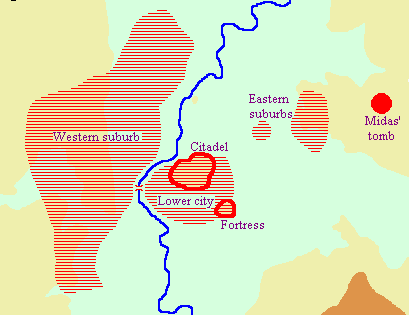
Gordium was the capital of ancient Phrygia, modern Yassihüyük. It is situated on the place where the ancient Royal road between Lydia and Assyria / Babylonia crosses the river Sangarius, which flows from central Anatolia to the Black Sea.Remains of the road are still visible. In the ninth century BCE, the city became the capital of the Phrygians, a Thracian tribe that had invaded and settled in Asia. They created a large kingdom that occupied the greater part of Turkey west of the river Halys.
The kings of Phrygia built large tombs near Gordium. These wooden chambers were covered by artificial hills that are usually called tumuli. There are about eighty of them; forty have been investigated by archaeologists, and turn out to cover the period from the eighth to the first century BCE.
In the eighth century, the citadel was fortified and in the next century, the town became very large indeed. A palace was built in the citadel. To the south of it was a lower city, and a large suburb was to be found on the other bank of the Sangarus.
The most famous king of Phrygia was Midas, who is little more than a name to us. However, contemporary Assyrian refer to a Mit-ta-a, king of Muški. If he is identical to the legendary Midas - which is contested - he cooperated with the rulers of Tyana, Karkemiš, Gurgum, and Malida against the Assyrian king Sargon II, but was attacked by a nomadic tribe called Cimmerians.In 710/709, Midas was forced to ask for help from Sargon. This did not prevent the Cimmerian invasion. Another source, the Chronicle of Eusebius, tells us that the legendary Midas died in 695 - he may have committed suicide after a lost battle. There are traces of destruction at Gordium, but they may be older than the attack by the Cimmerians - and, again, it is unclear whether Muški is identical to Phrygia amd Mit-ta-a to Midas.
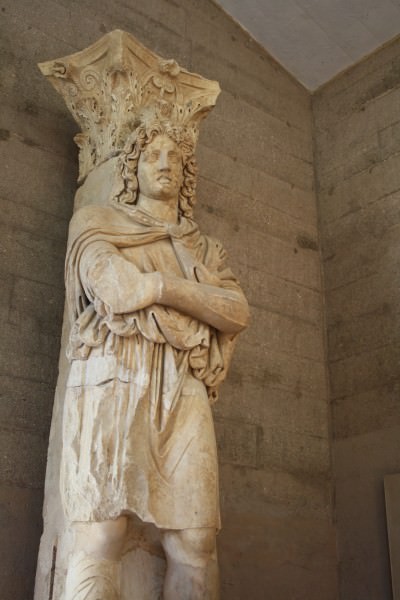
Phrygian Captive, Corinth
The "mound of Midas", the greatest tumulus near Gordium, was excavated in 1957. Its diameter is a little short of 300 meters and it is 43 meters high. In the wooden chamber, which measured 5 x 6 meters, a man's corpse was found, and even the contents of his last dinnerr could be reconstructed. The tumulus also contained one of the oldest alphabetic inscriptions outside Phoenicia (c.740 BCE).
After half a century of confusion, western Turkey was reunited by the Lydians, whose first great king was Gyges (c.680-c.644).During the reign of one of his successors, Alyattes (c. 600-560), the wall of the citadel was rebuilt, while a massive fortress was built on a hill next to it. From this moment on, Greek ceramics became fashionable: initially from the Ionian cities, later also from Laconia, and especially Athens.
After half a century of confusion, western Turkey was reunited by the Lydians, whose first great king was Gyges (c.680-c.644).During the reign of one of his successors, Alyattes (c. 600-560), the wall of the citadel was rebuilt, while a massive fortress was built on a hill next to it. From this moment on, Greek ceramics became fashionable: initially from the Ionian cities, later also from Laconia, and especially Athens.
When Lydia was conquered by the Persian king Cyrus the Great and its last king Croesus killed (after 547), a Persian garrison took possession of this fortress. Gordium was now included in the satrapy of Greater Phrygia. Ceramics from this period sometimes imitate Achaemenid silver vessels, while the town appears to have exported textile.
The garrison stayed there until the last months of 334, when the Macedonian commander Parmenion captured the city. During the winter, his king Alexander the Great joined him. (Go here for the famous story about Alexander cutting the Gordian knot in the palace.)
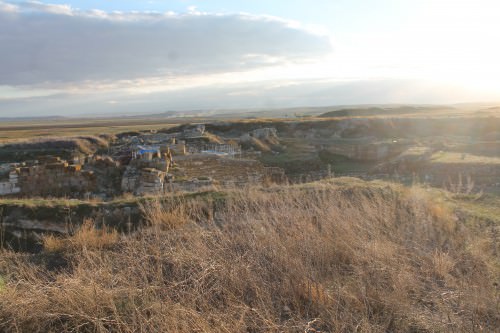
Gordium, capital city of ancient Phrygia
After the troubles following the death of Alexander in 323, Gordium was first ruled by Antigonus, then by the Seleucid kings of Asia, then by the Celts (the remains of their human sacrifices have been found), then by the Attalid rulers of Pergamon, and eventually by the Romans.
It remained one of the most important commercial centers in the region, still producing textiles. However, the size of the city itself diminished. The old center - citadel and lower town - was abandoned after the Roman conquest in 189 BCE; only the western suburbs remained occupied. (From the first until the fourth century CE, part of the citadel was again in use.) Gordium was still in existence in the sixth century, and was probably called Vindia, which suggests that people no longer remembered its Phrygian past.
Uruk › Ancient History
Definition and Origins
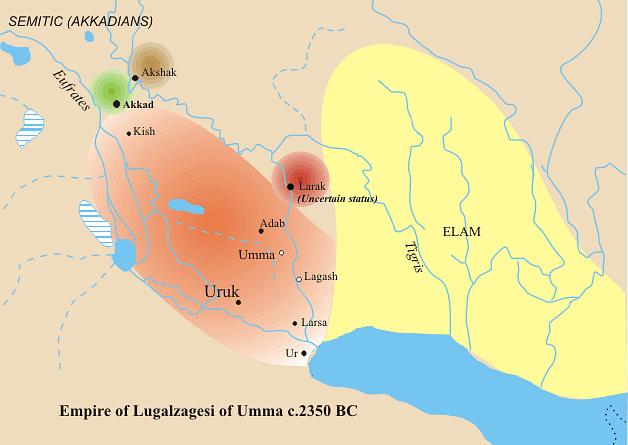
Uruk was one of the most important cities (at one time, the most important) in ancient Mesopotamia. According to the Sumerian King List, it was founded by King Enmerkar sometime around 4500 BCE. Located in the southern region of Sumer(modern day Warka, Iraq), Uruk was known in the Aramaic language as Erech which, it is believed, gave rise to the modern name for the country of Iraq (though another likely derivation is Al-Iraq, the Arabic name for the region of Babylonia ). The city of Uruk is most famous for its great king Gilgamesh and the epic tale of his quest for immortality but also for a number of `firsts' in the development of civilization which occurred there. It is considered the first true city in the world, the origin of writing, the first example of architectural work in stone and the building of great stone structures, the origin of the ziggurat, and the first city to develop the cylinder seal which the ancient Mesopotamians used to designate personal property or as a signature on documents. Considering the importance the cylinder seal had for the people of the time, and that it stood for one's personal identity and reputation, Uruk could also be credited as the city which first recognized the importance of the individual in the collective community. The city was continuously inhabited from its founding until c. 300 CE when, owing to both natural and man-made influences, people began to desert the area. It lay abandoned and buried until excavated in 1853 CE by William Loftus for the British Museum.
THE URUK PERIOD
The Ubaid Period (c. 5000-4100 BCE) when the so-called Ubaid people first inhabited the region of Sumer is followed by the Uruk Period (4100-2900 BCE) during which time cities began to develop across Mesopotamia and Uruk became the most influential. The Uruk Period is divided into 8 phases from the oldest, through its prominence, and into its decline based upon the levels of the ruins excavated and the history which the artifacts found there reveal. The city was most influential between 4100-c.3000 BCE when Uruk was the largest urban center and the hub of trade and administration. In precisely what manner Uruk ruled the region, why and how it became the first city in the world, and in what manner it exercised its authority is not fully known. The historian Gwendolyn Leick writes, “The Uruk phenomenon is still much debated, as to what extent Uruk exercised political control over the large area covered by the Uruk artifacts, whether this relied on the use of force, and which institutions were in charge. Too little of the site has been excavated to provide any firm answers to these questions. However, it is clear that, at this time, the urbanization process was set in motion, concentrated at Uruk itself” (183-184). Since the city of Ur had a more advantageous placement for trade, further south toward the Persian Gulf, it would seem to make sense that city, rather than Uruk, would have wielded more influence but this is not the case.
THE CITY WAS MOST INFLUENTIAL BETWEEN 4100-C.3000 BCE WHEN URUK WAS THE LARGEST URBAN CENTER AND THE HUB OF TRADE AND ADMINISTRATION.
Artifacts from Uruk appear at virtually every excavated site throughout Mesopotamia. The historian Julian Reade notes, “Perhaps the most striking example of the wide spread of some features of the Uruk culture consists in the distribution of what must be one of the crudest forms ever made, the so-called beveled-rim bowl. This kind of bowl, mould-made and mass-produced, is found in large numbers throughout Mesopotamia and beyond” (30). This bowl was the means by which workers seem to have been paid: by a certain amount of grain ladled into a standard-sized bowl. The remains of these bowls, throughout all of Mesopotamia, suggest that they “were frequently discarded immediately after use, like the aluminum foil containing a modern take-away meal” (Reade, 30). So popular was the beveled-rim bowl that manufacturing centres sprang up throughout Mesopotamia extending as far away from Uruk as the city of Mari in the far north. Because of this, it is unclear if the bowl originated at Uruk or elsewhere (though Uruk is generally held as the bowl's origin). If at Uruk, then the beveled-rim bowl must be counted among the many of the city's accomplishments as it is the first known example of a mass-produced product.
THE CITY DISTRICTS & GODS
The city was divided into two sections, the Eanna District and the older Anu District, named for, and dedicated to, the goddess Inanna and her grand-father-god Anu, respectively. The famous Mask of Warka (also known as `The Lady of Uruk') a sculpted marble female face found at Uruk, is considered a likeness of Inanna and was most likely part of a larger work from one of the temples in her district. The Eanna District was walled off from the rest of the city but it is unclear if this was for ceremonial purposes or if, in building the newer Eanna District, the builders required a wall for some reason. The historian Samuel Noah Kramer suggests that Anu, the male god, presided over the early city until the rise in popularity of his daughter Inanna and, at this time, she was given a private dwelling, complete with a wall, in the Eanna District. Since temples were considered the literal dwelling place of deities on earth, and since Inanna is regularly depicted as a goddess who very much preferred things her own way, perhaps the walled district was simply to provide her with some privacy. Kramer also notes that, even though Inanna continued to be a popular deity throughout Mesopotamia (eventually merging into Ishtar ) goddesses declined in power and prestige at the same time, and at the same rate, as women's rights deteriorated. This being the case, perhaps the Eanna district was walled off to restrict access to a male priestly class. As with much concerning Uruk's history, however, this theory remains largely speculation.
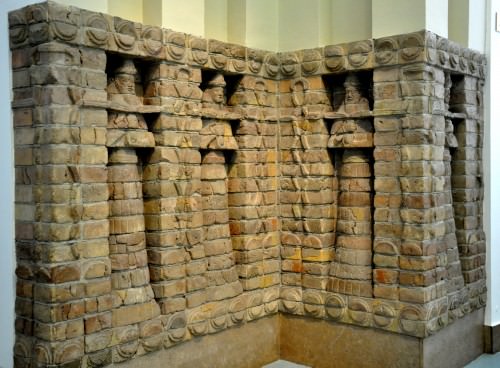
Facade of Inanna's Temple at Uruk
Inanna played a pivotal role in the mythological history of Uruk as it was she who stole the sacred meh from her father-god Enki at the sacred city of Eridu and brought them to Uruk. The meh were, in the words of Kramer (who first translated the cuneiform ) “divine decrees which are the basis of the culture pattern of Sumerian civilization.” As Eridu was considered, by the Sumerians, the first city created by the gods and a place holy to them, the removal of the meh to Uruk signified a transference of power and prestige from one city to the other. In the tale of Inanna and The God of Wisdom, Enki god goes to great lengths, once he finds the meh are stolen, to have them brought back to Eridu – but in vain. Inanna has tricked her father and now Uruk, not Eridu, would be the seat of power. Eridu was associated with rural life and the primordial sea from which life sprang; Uruk was the embodiment of the new way of life – the city. The story would have provided an ancient Mesopotamian with the reason why Eridu declined in importance and Uruk rose to the heights it did: it was the work of the gods.
URUK'S IMPORTANCE & LONG DECLINE
During the Early Dynastic Period (2900-2334 BCE), which followed the Uruk Period, Uruk was still the seat of power in the region, though in a much diminished state, and the major dynasties of the time ruled from the city. The great wall of Uruk, which was said to have been built by King Gilgamesh himself, still rose around the city when King Eannutum forged his First Dynasty of Lagash in 2500 BCE and established the first empire in the region. The later king of that empire, Lugal-Zage (also known as Lugalzagesi), so admired the city that he chose Uruk as his capital and seat of power. When Sumer was brought under the rule of the Akkadian Empire in 2334 BCE, Sargon of Akkad continued to pay special reverence to Uruk and the sacred districts of Inanna and Anu continued in use and, in fact, were renovated and improved upon.
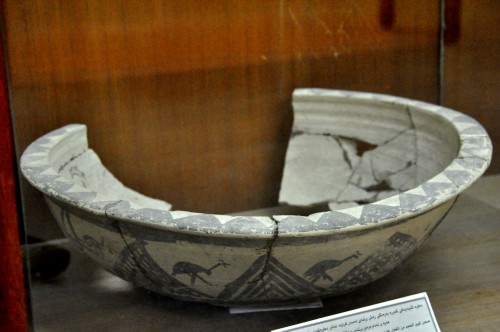
Pottery Dish from Uruk Period
Even though the city lost the position of pre-eminence it had enjoyed during the Uruk Period, it continued to play an important position down through the Ur III Period (2047-1750 BCE). The Third Dynasty of Ur governed in such a way as to give birth to a Sumerian Renaissance and Uruk benefited from this as much as the rest of the region. With the fall of the city of Ur in 1750 BCE and the invasion of Sumer by Elamites, along with the incursions of the Amorites, Uruk went into decline along with the rest of Sumer. The city continued to play a significant role, however, throughout the Seleucid and Parthian periods of Sumer's late history. This is a substantial point to note in that many other Sumerian cities fared far less well at this same time. The sacred districts continued to be maintained, though to lesser degrees, into the 7th century CE; long past the time when many other Mesopotamian cities had been abandoned. The historian Bertman writes, “Uruk had a life-span of 5,000 years. Its oldest layers lie virtually unexplored, submerged deep in the mud of the alluvial plain from which its life once sprouted” (37. Perhaps buried in the ancient ruins is the answer to why the first city in the world rose as it did, where it did, and remained so important to the people of Mesopotamia for so long. Unlike other cities throughout the region, it was not abandoned until the Muslim Conquest of Mesopotamia in 630 CE.
The answer to the mystery of Uruk's prominence, however, may be simpler than it appears. The historian Paul Kriwaczek has noted that any important change in a society springs from “the everlasting conflict between progressives and conservatives, between the forward and backward looking, between those who propose `let's do something new' and those who think `the old ways are best'. No great shift in culture ever took place without such a contest” (21). Perhaps the story of Inanna and Enki and the shift of power from Eridu to Uruk told of this very contest and showed how the old ways of rural life, exemplified in the ancient site of Eridu, gave way to the rise of the city and a new kind of community. It had to happen somewhere, once the process of urbanization began, and the place where it happened was at Uruk.
MAP
LICENSE:
Article based on information obtained from these sources:with permission from the Website Ancient History Encyclopedia
Content is available under License Creative Commons: Attribution-NonCommercial-ShareAlike 3.0 Unported. CC-BY-NC-SA License